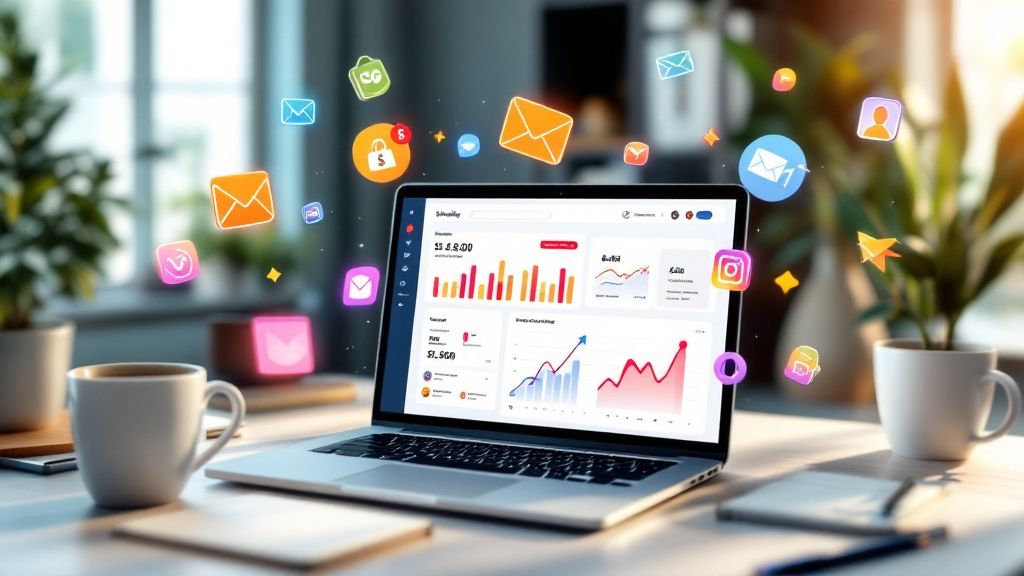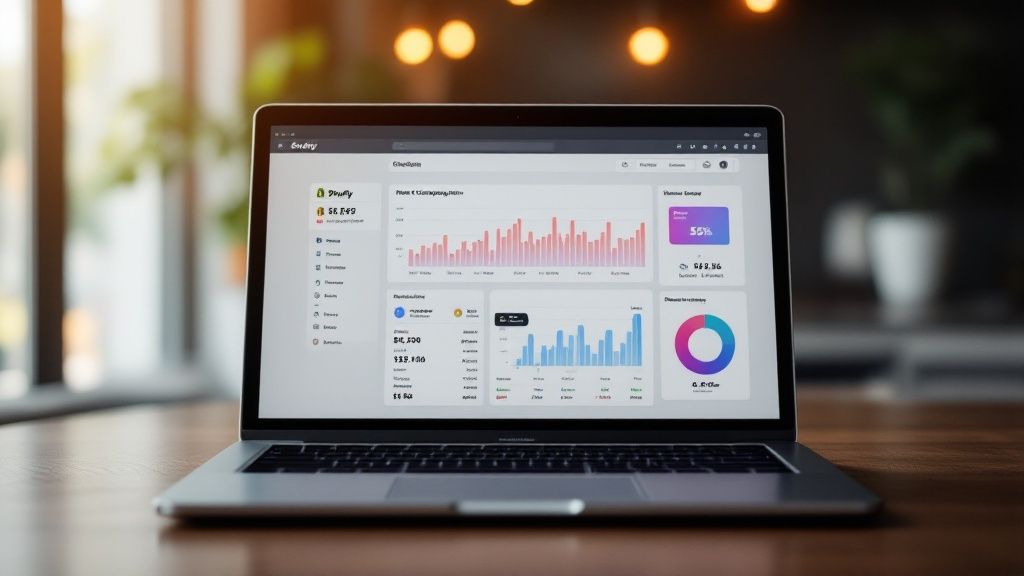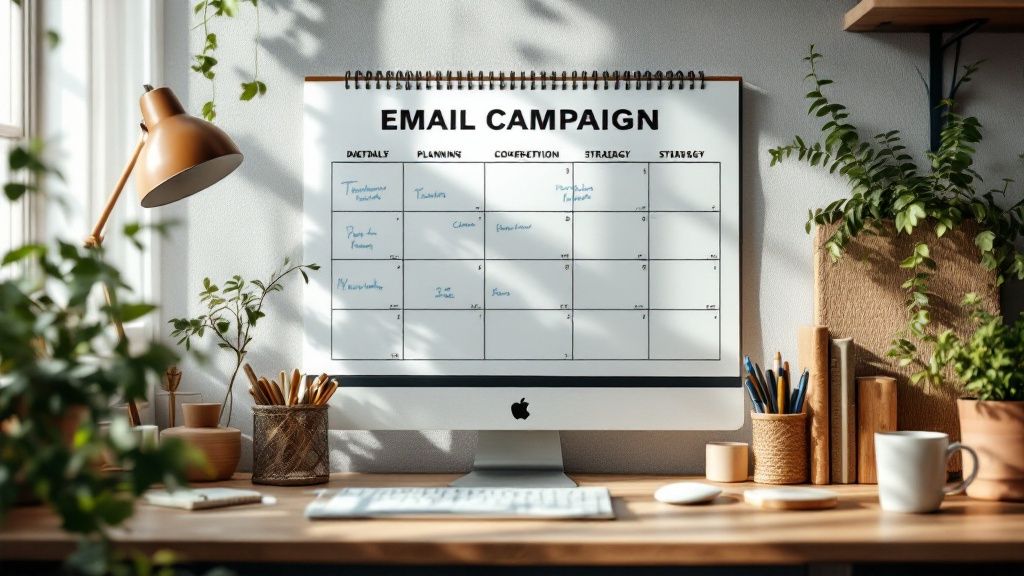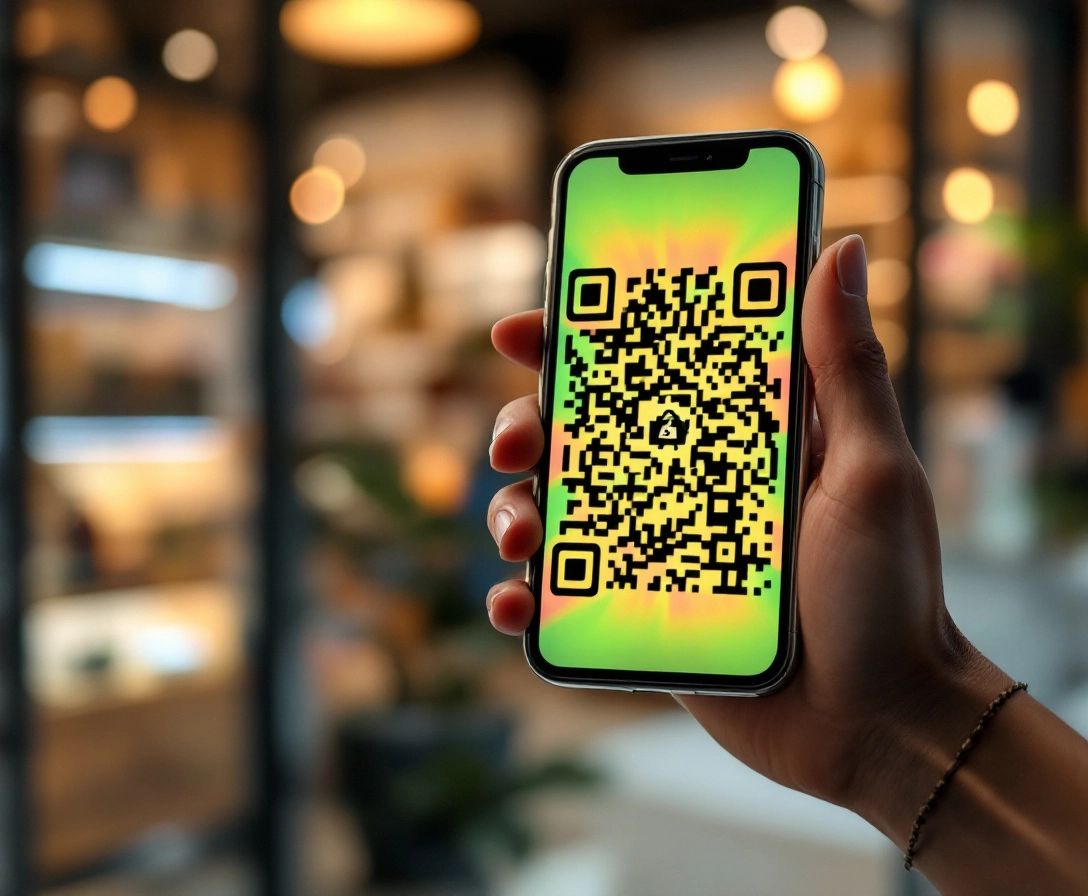Boost Your Email Campaign Shopify Success!
February 25, 2025

Why Shopify Email Campaigns Outperform Other Channels

Email gives you something special – a direct line to customers who already like your brand. Unlike social posts or paid ads, email marketing on Shopify lets you speak directly to interested shoppers. This personal connection helps build real relationships and drive more sales.
The Power of Personalized Communication
With Shopify's customer data capabilities, you can see what products people browse and buy. This insight helps create targeted emails that feel personal. For instance, you can recommend items based on past purchases. When messages feel tailored to the individual, engagement goes up. These personalized touches encourage repeat business and build loyalty over time.
Seamless Integration With Your Store
The email tools built into Shopify make it easy to manage customer communications. You can segment your audience, set up automated emails, and track results – all in one place. This tight integration ensures your brand looks and feels consistent everywhere customers interact with you. A unified experience builds recognition and trust.
Cost-Effective Marketing Solution
Email marketing delivers exceptional ROI compared to paid advertising. While ads need constant budget, an active email list keeps producing results. This makes email perfect for small businesses watching costs. Shopify email campaigns achieve an impressive 4.29% conversion rate, beating other channels like direct mail and social media ads. Learn more about email marketing effectiveness. For maximizing your marketing budget, email is hard to beat.
Building Relationships, Not Just Transactions
Email helps nurture customer connections beyond single purchases. Regular newsletters, product updates and special offers keep your brand top of mind. Sharing helpful content and exclusive deals strengthens the bond between customer and brand. This ongoing relationship leads to more repeat business.
Automated Workflows for Enhanced Efficiency
Shopify lets you set up automated email sequences triggered by customer actions. Welcome emails, cart reminders, and post-purchase follow-ups go out automatically. This ensures timely, relevant communication while saving you work. The efficiency lets you focus on other business priorities. These features show why email remains essential for Shopify stores looking to grow sales and customer relationships.
Metrics That Drive Email Campaign Success

Creating successful Shopify email campaigns requires understanding key performance indicators that show what's working and what needs improvement. These metrics provide clear insights into how subscribers interact with your emails and help identify opportunities to increase revenue.
Here's an overview of industry benchmarks for common email marketing metrics:
| Metric | Good Performance | Excellent Performance | Actions to Improve |
|---|---|---|---|
| Deliverability Rate | 90-95% | >95% | Clean email list, improve sender reputation |
| Open Rate | 15-20% | >25% | Test subject lines, optimize send times |
| Click-Through Rate | 2-3% | >4% | Improve CTA design, strengthen offers |
| Conversion Rate | 1-2% | >3% | Enhance targeting, optimize landing pages |
| Unsubscribe Rate | <0.5% | <0.2% | Review content quality, adjust frequency |
| Bounce Rate | <3% | <1% | Validate emails, remove inactive contacts |
Key Metrics to Monitor
Several metrics can tell you how well your email campaigns perform:
-
Deliverability Rate: Measures emails successfully reaching inboxes. A rate below 95% suggests list quality or sender reputation issues.
-
Open Rate: Shows the percentage of recipients opening your emails. Strong subject lines typically achieve 20% or higher opens.
-
Click-Through Rate (CTR): Tracks link clicks within emails. Most campaigns average 2-3% CTR.
-
Conversion Rate: Measures recipients who complete desired actions like purchases. This directly ties email efforts to sales.
-
Unsubscribe Rate: The percentage leaving your list after campaigns. High rates often indicate content or frequency problems.
-
Bounce Rate: Failed email deliveries, split between temporary (soft) and permanent (hard) bounces.
Check out more detailed email marketing statistics on Shopify's blog.
Setting Benchmarks and Taking Action
When reviewing metrics, consider your industry and audience. For example, luxury brands often see lower open rates but higher order values compared to discount retailers.
Using Data to Optimize Your Shopify Email Campaigns
Let data guide your email strategy improvements. Low open rates mean testing better subject lines. Poor click rates suggest revising calls-to-action or email designs. Regular metric analysis helps refine campaigns for better results.
Utilizing Tools for Enhanced Performance
Several tools can boost email performance on Shopify. Checkout Links creates shoppable email links that pre-fill carts and apply discounts. Klaviyo enables advanced segmentation and personalized content delivery. These tools help translate metrics into meaningful improvements that drive engagement and sales.
Unlocking Advanced Shopify Email Analytics

Getting the most from your Shopify email campaigns requires looking beyond basic metrics. The most successful merchants know that analyzing detailed customer data leads to better results. This means carefully studying behavior patterns, identifying key customer groups, and using data to predict which campaigns will perform best.
Shopify Email provides merchants with essential campaign metrics like open rates, click rates, delivery stats, bounces, and unsubscribes. Understanding these numbers gives you clear insights into how customers interact with your emails and helps guide smart marketing decisions.
Segmenting Your Audience for Targeted Campaigns
One powerful feature of email analytics is the ability to create targeted customer segments. You can group customers based on what they've bought, who they are, or how they use your site. For example, you might send special dog treat offers only to customers who buy pet products. This personal touch makes your emails more relevant and effective than sending the same message to everyone.
Optimizing Campaign Timing for Maximum Impact
Sending emails at the right time dramatically improves their success. By tracking when subscribers are most active, you can schedule campaigns for peak engagement hours. Think of it like fishing – you'll catch more fish when they're actually biting. Tools like Klaviyo work seamlessly with Shopify to automatically send emails at the best times for your audience.
Personalizing Content with Dynamic Data
Dynamic content takes email personalization to new heights. Your emails can automatically include content based on each customer's purchase history, browsing behavior, and location. This creates truly individual experiences. With tools like Checkout Links, you can add personalized product suggestions and exclusive discounts directly in your emails – something basic email tools simply can't match.
Leveraging Custom Tracking for Deeper Insights
Custom tracking provides detailed data about specific actions in your email campaigns, like which links get clicked or which calls-to-action work best. This granular information helps you understand exactly how customers behave and lets you improve future campaigns based on real results. For instance, tracking clicks on different product categories shows what customers are most interested in, helping you send more relevant emails going forward.
Mastering Email Deliverability on Shopify

Getting your carefully crafted emails into customer inboxes is just as critical as creating great content. Email deliverability directly impacts the success of your Shopify email marketing efforts. This guide covers practical ways to ensure your messages reach their intended destination.
Maintaining a Healthy Subscriber List
Think of your email list like a garden that needs regular care. A clean list with engaged subscribers is key to good deliverability. Remove subscribers who haven't opened your emails in months. While it may feel strange to shrink your list, an active smaller list often performs better than a large inactive one. Email providers notice when subscribers consistently engage with your messages.
The Importance of Easy Unsubscribes
Make it simple for people to opt out of your emails. When subscribers can't easily unsubscribe, they're more likely to mark messages as spam, which damages your sender reputation. Think of sender reputation like a credit score – once damaged, it takes time to rebuild. A clear unsubscribe process helps maintain trust.
To learn more about email deliverability best practices on Shopify, check out their official guide here. For additional tips, read this detailed post on how to master email deliverability.
Strategies for Reducing Bounce Rates
Pay close attention to bounced emails. Remove hard bounces (invalid addresses) right away. Monitor soft bounces (full inboxes) and remove subscribers after repeated bounces. Consistent bounces suggest an inactive subscriber who should be removed. Regular list maintenance helps keep bounce rates low.
Managing Spam Complaints and Building Engagement
Even legitimate emails can trigger spam complaints. The best defense is sending targeted, valuable content that subscribers actually want. Break your list into segments based on interests and behaviors. This personal touch builds engagement while reducing spam reports. Track which content resonates with different segments and adjust accordingly. Regular analysis of key metrics helps you understand what works for your specific audience.
Crafting High-Converting Email Content
The best email campaigns create real connections with your audience. Let's explore how to develop email campaigns for Shopify that get opened and drive sales.
The Importance of Compelling Subject Lines
Your subject line makes the critical first impression. A well-crafted subject line can mean the difference between an opened email and one that gets deleted unread. Keep subject lines brief and focus on communicating clear value. Adding personal touches like using the recipient's name or mentioning their previous purchases can boost open rates by 20-30%. For instance, "Sarah, Here's That Summer Collection You Asked About" works better than a generic "New Summer Arrivals."
Designing Engaging Layouts for Shopify Emails
Good email design keeps readers scrolling and clicking. Structure your content with clear headings and plenty of white space. Include high-quality product photos that showcase your items effectively. With over 60% of emails now opened on mobile devices, responsive design is essential. Think of your email as a digital storefront – it needs to be both visually appealing and easy to navigate.
Writing Copy That Drives Action
Focus your email copy on specific customer benefits and use clear calls to action that motivate purchases. Instead of basic "Buy Now" buttons, try benefit-focused CTAs like "Save 20% Today Only" or "Get Free Shipping." Break up text into scannable chunks and highlight key points with bullet lists.
Frameworks for Different Campaign Types
Each type of email campaign needs its own approach. Abandoned cart emails work best with gentle reminders and special offers to complete the purchase. Loyalty program messages should recognize customer value and highlight exclusive perks.
Want more email marketing insights? Check out this guide on email marketing best practices for data, engagement, and ROI.
Templates You Can Adapt for Your Store
Starting with proven templates saves time, but personalizing them is key. Modify templates to match your brand voice and style. Test different versions to see what resonates with your audience.
Utilizing Checkout Links for Enhanced Conversions
Checkout Links helps boost email campaign results by making purchasing seamless. Create links that automatically add items to carts and apply discounts. This works especially well for abandoned cart recovery – customers can resume shopping with a single click.
Different Campaign Types and Their Best Practices
Here's a breakdown of key email campaign types and how to optimize each one:
| Campaign Type | Best Use Case | Key Elements | Expected Results |
|---|---|---|---|
| Welcome Email | New Subscribers | Warm greeting, brand introduction, special offer | Build rapport, encourage first purchase |
| Abandoned Cart Recovery | Remind customers about items left in their cart | Product images, clear call to action, discount offer | Recover lost sales |
| Product Launch Announcement | Introduce new products | High-quality product images, detailed descriptions, exclusive early bird offer | Generate excitement, drive initial sales |
| Loyalty Program Email | Reward loyal customers | Exclusive discounts, early access to sales, personalized recommendations | Increase customer retention, boost lifetime value |
| Post-Purchase Follow-Up | Thank customers for their purchase | Cross-sell/upsell related products, request product reviews | Build customer relationships, encourage repeat purchases |
By creating targeted content, using effective design, and implementing tools like Checkout Links strategically, you can build email campaigns that consistently drive more sales. Keep testing different approaches and refining based on your results.
Building Powerful Automation Workflows
Email automation in Shopify can turn your manual marketing tasks into an automatic revenue generator. Smart email sequences nurture customers at every stage while driving sales, even outside business hours. By understanding what works best for successful Shopify sellers, you can develop targeted campaigns that convert.
Automating Key Touchpoints in the Customer Journey
Think of your email automation like a carefully planned path guiding shoppers through their buying journey. The first step is sending a friendly welcome message when someone joins your list. This email introduces your brand personality and often includes a special first-time offer.
Cart abandonment emails come next, gently reminding shoppers about items they left behind. A small discount can help motivate them to complete their purchase.
After a sale, follow-up emails thank customers and suggest related products they might like. You can also ask for reviews to build social proof. These touchpoints keep customers engaged and encourage repeat purchases.
Workflow Templates for Shopify Email Campaigns
These ready-to-use templates help you get started quickly:
-
Welcome Series: A set of emails that greets new subscribers, tells your brand story, and offers a discount.
-
Abandoned Cart Flow: 1-3 reminder emails about left-behind items, with increasing incentives to buy.
-
Post-Purchase Sequence: Order confirmation, shipping updates, product recommendations, and review requests.
-
Re-engagement Campaign: Emails to win back inactive subscribers using exclusive offers and helpful content.
Trigger Recommendations for Enhanced Engagement
Email workflows start automatically based on customer actions. Choose triggers that match key shopping moments:
- Sign-up: Starts welcome series
- Abandoned Cart: Begins cart recovery emails
- Purchase: Sends order updates and product suggestions
- Browse Abandonment: Follows up on viewed items
- Product Views: Shares info about specific items
Integrating Email With Other Shopify Tools
Connect your emails to other Shopify apps for better results. Using Checkout Links lets you create custom shopping links that pre-fill carts and apply discounts. This smooth checkout process helps recover abandoned carts and boost email sales.
Real-World Success: Automating for Growth
Shopify sellers see great results from smart automation. An apparel brand boosted cart recovery by 15% using personalized emails with shoppable checkout links. A jewelry store increased customer value 12% through automated post-purchase emails with targeted product suggestions and member-only discounts.
Take your email marketing from manual to automated. Use Shopify's email tools and apps like Checkout Links to build campaigns that drive real growth.
 Checkout Links
Checkout Links



